
What controls ‘size’ in biological systems is a fundamental question but the intrinsic mechanism that mediates this control remains largely unknown. The goal of our research is to unravel genetic mechanisms that determine cell and organ size in plants and to explore new strategies to improve yield and quality of economically important plant species. Cell and organ size in plants is defined by highly dynamic, intersecting signalling pathways that involve genetic, hormonal and environmental cues. Using loss-of-function and gain-of-function mutants of the model plant Arabidopsis, we identify sets of genes that act in these pathways and unravel complex regulatory networks that control cell and organ size in higher plants.
![]()
Endocycle Transition
Developmental control of the mitotic-to-endocycle transition
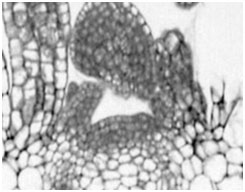 <b>The longitudinal section of the Arabidopsis shoot apical meristem</b><br>As leaving the meristem, many cells switch from the mitotic cycle to the endoreduplication cycle and start cell expansion/differentiation. Plant growth and development start at the meristem where cells actively proliferate via the mitotic cycle to promote the outgrowth of various plant organs. As soon as cells leave the meristem, however, many cells switch into an alternative cell cycle called endoreduplication cycle or endocycle and start cell expansion and/or differentiation. To maintain the healthy structure and function of the plant meristem, cells need to transit from the mitotic cycle into the endocycle at the right place and time.
<b>The longitudinal section of the Arabidopsis shoot apical meristem</b><br>As leaving the meristem, many cells switch from the mitotic cycle to the endoreduplication cycle and start cell expansion/differentiation. Plant growth and development start at the meristem where cells actively proliferate via the mitotic cycle to promote the outgrowth of various plant organs. As soon as cells leave the meristem, however, many cells switch into an alternative cell cycle called endoreduplication cycle or endocycle and start cell expansion and/or differentiation. To maintain the healthy structure and function of the plant meristem, cells need to transit from the mitotic cycle into the endocycle at the right place and time. 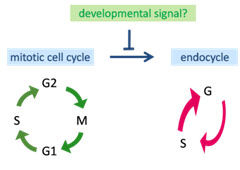 Using Arabidopsis as a model system, we study how this cell cycle transition is regulated by developmental cues and how this cell cycle control influences cell differentiation at the meristem. From a new genetic screen using flow cytometry, we have identified several novel mutants defective in the cell cycle transition. We have recently shown that a nuclear-localised SUMO E3 ligase, HIGH PLOIDY2 (HPY2), is required for the timely entry into the endocycle and meristem maintenance.
Using Arabidopsis as a model system, we study how this cell cycle transition is regulated by developmental cues and how this cell cycle control influences cell differentiation at the meristem. From a new genetic screen using flow cytometry, we have identified several novel mutants defective in the cell cycle transition. We have recently shown that a nuclear-localised SUMO E3 ligase, HIGH PLOIDY2 (HPY2), is required for the timely entry into the endocycle and meristem maintenance.
Plant cell growth
Transcriptional control of plant cell growth
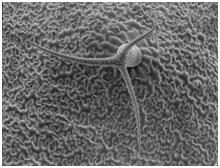 <b>Leaf trichome cell in Arabidopsis</b> Final size of plant cells is often fairly constant within a given species, thus the extent of plant cell growth should be tightly regulated by genetic mechanisms. Recent studies have identified various key factors promoting plant cell growth but whether plants also have a mechanism to actively terminate cell growth has remained elusive.
<b>Leaf trichome cell in Arabidopsis</b> Final size of plant cells is often fairly constant within a given species, thus the extent of plant cell growth should be tightly regulated by genetic mechanisms. Recent studies have identified various key factors promoting plant cell growth but whether plants also have a mechanism to actively terminate cell growth has remained elusive.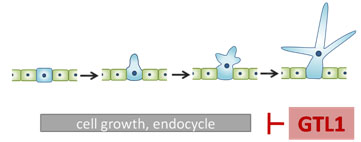 <b>Role of GTL1 in trichome development</b><br>Only a small proportion of leaf epidermal cells, e.g. the one marked in blue, differentiate into trichomes and start cell growth. The GTL1 gene is expressed at the last stage of trichome development to terminate its growth. Trichome cell growth is tightly coupled with an increase in the ploidy level through endoreduplication. GTL1 suppresses the endocycle progression beyond the wild-type level. Using the Arabidopsis trichome as an experimental system, we have screened the FOX mutant population, a gain-of-function mutant collection, in which full-length cDNA from Arabidopsis is individually over-expressed (Ichikawa et al, Plant J 2006), and isolated novel mutants that show an increase in final cell size. From our analysis of these mutants, we have recently demonstrated that a plant-specific trihelix transcription factor GT-2-LIKE 1 (GTL1) participates in the repression of ploidy-dependent cell growth in the Arabidopsis trichomes.
<b>Role of GTL1 in trichome development</b><br>Only a small proportion of leaf epidermal cells, e.g. the one marked in blue, differentiate into trichomes and start cell growth. The GTL1 gene is expressed at the last stage of trichome development to terminate its growth. Trichome cell growth is tightly coupled with an increase in the ploidy level through endoreduplication. GTL1 suppresses the endocycle progression beyond the wild-type level. Using the Arabidopsis trichome as an experimental system, we have screened the FOX mutant population, a gain-of-function mutant collection, in which full-length cDNA from Arabidopsis is individually over-expressed (Ichikawa et al, Plant J 2006), and isolated novel mutants that show an increase in final cell size. From our analysis of these mutants, we have recently demonstrated that a plant-specific trihelix transcription factor GT-2-LIKE 1 (GTL1) participates in the repression of ploidy-dependent cell growth in the Arabidopsis trichomes.
Plant organ size
Molecular control of plant organ size
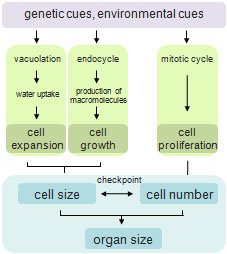 The final size of an organ is determined by a coordinated balance between cell expansion and cell expansion. What controls organ size is a fascinating and important question in both basic and applied biology. The final size of an organ is determined through a coordinated balance between cell proliferation and cell expansion, and we are just beginning to understand how these processes are mediated at the molecular level.
The final size of an organ is determined by a coordinated balance between cell expansion and cell expansion. What controls organ size is a fascinating and important question in both basic and applied biology. The final size of an organ is determined through a coordinated balance between cell proliferation and cell expansion, and we are just beginning to understand how these processes are mediated at the molecular level.  An example of a FOX mutant that develops larger leaves than wild-type plants. To gain further insights into organ-size control in plants, we have isolated several gain-of-function mutants using the Arabidopsis FOX mutant collection (Ichikawa et al, Plant J 2006). We are currently investigating the function of corresponding genes to unravel novel genetic pathways responsible for the plant organ-size regulation.
An example of a FOX mutant that develops larger leaves than wild-type plants. To gain further insights into organ-size control in plants, we have isolated several gain-of-function mutants using the Arabidopsis FOX mutant collection (Ichikawa et al, Plant J 2006). We are currently investigating the function of corresponding genes to unravel novel genetic pathways responsible for the plant organ-size regulation.
・Unearthing the mechanisms controlling plant size (Frontlines, RIKEN Research, January 2011)
・Gene controlling plant cell growth discovered (1 September 2009)













